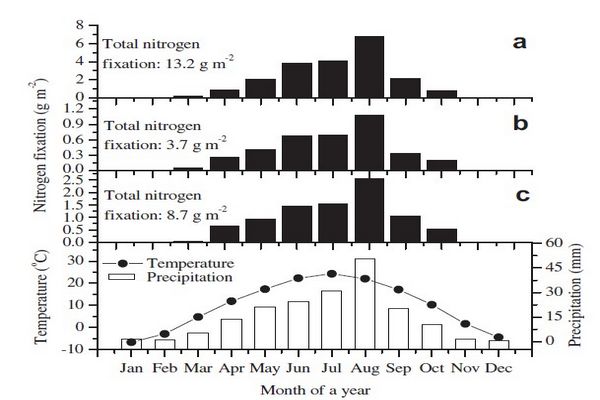Nitrogen fixation in biological soil crusts from the Tengger desert, northern China
Updatetime:2011-08-30From:
【Enlarge】【Reduce】
Nitrogen fixation rates in arid and semiarid areas have long been assumed to be low due to high temperatures and low soil moisture,providing less than optimal conditions for N fixation.However, nitrogen fixation is widespread in desert ecosystems,especially in association with leguminous plants or in bacterial populations residing on the surface and in the interior of plant roots growing in rocks. The nitrogen fixation by these living organisms can facilitate soil formation and restoration of dry land. To date, desert nitrogen fixation has been studied mainly in used arid areas which locate at the margin of desert, while knowledge of desert soil micro-organisms remains fragmentary, especially in the biological soil crusts in arid and semiarid areas.
The research of Nitrogen fixation in biological soil crusts from the Tengger desert, northern China was finished recently by the researchers of Cold and Arid Regions Environmental and Engineering Research Institute. The researchers investigated the nitrogenase activity of three BSC types from the Tengger desert in responses to stimulated precipitation,temperature, and irradiance intensity. In addition, potential seasonal nitrogen fixation by BSCs was estimated using meteorological records. The nitrogenase activity of BSCs ranged from 2.6 to 16.6 mmol m-2 h-1 in this desert, and nitrogenase activity was significantly dependent on crust type, precipitation, and temperature, but not on irradiance. Cyanobacterial-algal crusts showed the highest nitrogenase activity (16.6 mmol m-2 h-1), followed by lichen crusts (6.9 mmol m-2 h-1), and moss crusts (2.6 mmol m-2 h-1).Cyanobacterial-algal crusts demonstrated maximum nitrogenase activity with 1.54 mm of precipitation,while the maximum activity for lichen and moss crusts occurred at 1.83 mm and 0.65 mm, respectively.The optimum temperature for nitrogenase activity ranged from 15 to 30 °C. Based on meteorological data,the potential nitrogen input was estimated to be 3.7-13.2 g m-2 a-1, and the high nitrogen fixation in this region resulted from the perfect match of optimum climate to the favorable environmental factors for BSC nitrogenase activity. This research demonstrated that BSCs are the main nitrogen input source in this temperate desert ecosystem. In particular, cyanobacterial-algal crusts, which are the first colonizers of the desert ecosystem, may mediate the majority of nitrogen fixation to facilitate soil nitrogen accumulation in these infertile soils.
The research was subsidized by the Chinese National Natural Scientific Foundation (41001067, 40930636, 40825001, and 40971156).
Full Text Download Here
crusts (b), and lichen crusts (c) by month, as well as average air temperature (°C) and
precipitation (mm) by month in the study area from 1955 to 2001
Appendix




